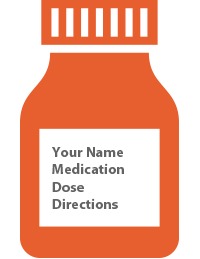Consumer "Good Catches" – Part 2: Know Where to Look
2019-03-06
This is the second of a 2-part series describing how consumers can spot medication mistakes. Part 1 of this series covered the importance of knowing what to expect from a medication. This type of knowledge can help consumers to stay safe and can go a long way toward preventing mistakes and harm. Knowing where to look for this information is just as important and is the topic of the current newsletter (part 2 of the series). Consumers can find this information by reading prescription bottle labels, reviewing product packaging, and searching online for other key details.
A consumer visiting a dentist for the first time completed a form. On this form, the consumer reported an allergy to penicillin, but wrote the information in the wrong part of the form. The dentist overlooked the reported allergy and prescribed an antibiotic called amoxicillin for the consumer. The pharmacist who dispensed the antibiotic also missed the allergy information. Luckily, the consumer read the drug information sheet from the pharmacy before taking any amoxicillin. This information sheet stated that amoxicillin is part of the penicillin family. The consumer's spouse searched the internet for more information and learned that amoxicillin should not be used by anyone who is allergic to penicillin.
SafeMedicationUse.ca has the following suggestions for consumers so that they will know where to look for important medication information:
-

-
Prescription bottle label: Check the label for your name, the name of the medication, its strength or dose, and the directions for use. Be sure that you understand any warning labels that have been placed on your prescription bottle. If the warnings are unclear, ask a healthcare professional for help.
-
Product packaging: Read the product packaging to help you understand whether you should be taking the medication and how to do so safely.
-
Online resources: If you are unsure about your medications, for any reason, you can learn more from trustworthy websites, such as www.medlineplus.gov or www.bodyandhealth.canada.com or www.canada.ca/en/services/health.html.
-
Your healthcare team: If you have any questions or concerns about your medications, or you simply want more information, talk to your doctor, nurse, or pharmacist. These healthcare professionals will be able to answer your questions or guide you in the right direction.
Medication safety bulletins contribute to Global Patient Safety Alerts
This newsletter was developed in collaboration with Best Medicines Coalition and Patients for Patient Safety Canada.
Recommendations are shared with healthcare providers, through the ISMP Canada Safety Bulletin, so that changes can be made together.
|

